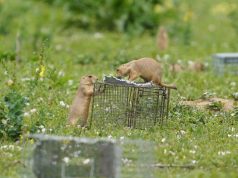
Just five days before the High Park Fire hit his home last summer, Mark Palke had signed official papers to buy the land he and his partners had been farming, renting and building alternative homes on for two years.
“The first feeling I had was helplessness,” he says. “The geodomes all burned. One didn’t, but a burned tree fell on it a few days later.”
Then the insurance company balked over technicalities. The team began rebuilding anyway.
“It was nonstop stress and work and smoke and ash for a month and a half, with no electricity,” Palke recounts. “But we got pretty lucky, compared to our neighbors.”
Some of the farm’s structures survived, while the neighbors’ homes were burned to the ground, stranding one family with 5-year-old twins.
As a farmer, Palke found a silver lining: the fire’s ashes. Inside his partially melted greenhouse, tomato plants were nearly buried in wet ash when rain rushed in.
Weeks later, the tomato plants exploded in a frenzy of growth. Now, the team uses the ash deposited in basins on their land. They mix it into their soil, like compost, for added nutrients.
The devastating wildfires that rage through Colorado produce this sooty black stuff that’s getting scientists excited. Black carbon, which includes charcoal and other matter, as well as other burned material, has been “overlooked for many years,” according to Christopher Licata, who has a Ph.D. in biology from the University of Denver.
“It was just something that blackened the landscape,” says Licata, a regional expert on wildfire-produced charcoal. Now, it’s the subject of a new study by Colorado State University in Fort Collins, near where, in 2012, the High Park Fire burned the second-largest area of any fire in recorded Colorado history. As black carbon’s potential uses are uncovered, Boulder County officials say they are considering producing it to add to soils where fires can’t be allowed to burn.
In Colorado, where many homes are near forests, last year’s fire season caused record destruction. More than 300 Colorado Springs homes burned to the ground in the Waldo Canyon Fire last June alone, breaking the record set a week earlier when more than 250 homes were lost in the High Park Fire. This summer isn’t predicted to be any better, says Chad Julian, senior resource specialist on forestry and fire at Boulder County Parks and Open Space. June is the most concerning month for the Front Range again, he said, based on modeling weather patterns in early March.
“In the past several thousand years, we’ve never had three wildfire seasons like this, back-to-back like this,” he says. “Patterns are starting to show effects of climate change.”
Boulder County is conducting “restoration projects,” including mechanical removal of some trees to reduce fuel for fires.
Preventing and fighting wildfires is necessary to save lives and homes, but it interferes with the natural fire cycle, other experts say.
“Fire is the primary driver of organic matter cycling in our Western forests,” Licata says. “From a fire ecologist standpoint, in the absence of humans, we need to let those fires burn. … If you can’t let a fire burn, the only answer is to mimic Mother Nature through the use of chainsaws and things like prescribed fires to reduce fuel.”
Boulder County foresters do use chainsaws in Open Space forests, reducing fuel for fires, according to Julian. But when trees are felled, not burned, the natural charcoal is never created. And in forests, charcoal matters. A 2011 study compared patches of burnt ground: The more charcoal present, the more pine seedlings germinated there, suggesting that charcoal plays a significant role in forest regeneration.
“We’re finding relationships every day in terms of the importance of charcoal,” says Licata, who studies charcoal produced by Front Range wildfires.
Charcoal allows soil to store nutrients that could otherwise be washed away, he says, and makes nutrients available that are needed for new trees to germinate. Those nutrients are usually made available by the teeming mosh pit of underground organisms that scientists call the “soil community.” And charcoal helps that productive soil community grow, scientists agree. When charcoal was added to soil samples in Senior Scientist Francesca Cotrufo’s lab at Colorado State University, it increased the size of the microbial community, she says.
Cotrufo’s new study, according to a Feb. 7 press release, aims to discover the portion of a wildfire’s burned material that becomes black carbon in the soil instead of being washed away or released to the atmosphere, and what that black carbon does in the soil.
“Understanding black carbon can be significant for management,” Cotrufo says. Her interest in black carbon in soil was inspired by her research on the ancient, rediscovered land management tool called “biochar.”
Biochar is a type of black carbon that’s produced by smoldering organic material without letting much oxygen get involved. Ancient Amazonian civilizations charred their waste and buried it to increase soil fertility. The scientist most often credited with bringing biochar into mainstream research is Johannes Lehmann, a soil science professor at Cornell University.
“Biochar can be a game-changer because it improves the ability of soil to retain nutrients,” Lehmann says. Black carbon produced by wildfires could similarly help soil, he says, by helping soil communities grow and by keeping nutrients from washing away.
Black carbon also sticks around after settling down in soil, Lehmann explains, and resists getting converted to carbon dioxide, one of the greenhouse gases affecting the atmosphere.
How that could affect climate change is a question raised by Cotrufo’s study. Knowing how much charcoal lingers after a fire, she says, will help scientists understand its role in the global carbon cycle.
Its role isn’t necessarily positive for climate change, Lehmann says, because a burning tree produces far more carbon dioxide than black carbon. But given black carbon’s longevity in soil, where it keeps that carbon out of the atmosphere, it’s hard to determine the net effect on climate change.
“That jury is still out,” Lehmann says. But one type of black carbon, biochar, also traps carbon safely in the soil, he says — and can be made without releasing nearly as much carbon dioxide as burning wood.
“Managers are burning trees affected by pine beetles,” he says. “Maybe we should be charring it rather than just burning it.”
Boulder County officials are considering it. Julian and Parks and Open Space Natural Resource Manager Therese Glowacki visited a biochar company called Biochar Now on March 8, and Glowacki says they’re interested in it as a way to use wood that isn’t “suitable” for the biomass energy that heats county buildings and a way to reduce the wood that’s being burned in slash piles or in the county’s “air curtain burner,” where some trees are sent after they’re removed to reduce fire risk or beetle infestation.
“But you can’t just go buy a biochar maker,” she says. It’s not commercially available yet. But making biochar isn’t impossible.
“The difference between fire and charring is practically to put a lid on it,” Lehmann says. If county officials decide where and how to char, biochar could enter our soils.
“Biochar is a great soil amendment, and not a chemical,” Glowacki says. “It has been shown to be pretty effective on hard-to-reclaim sites.”
Her first choice would be using it on Boulder County’s agricultural land, she says, but she would also consider putting it on the forest floor.
The studies on biochar’s effects on forests are happening now, according to other scientists. Licata is working on research that, when published, will help guide foresters hoping to mimic natural fire cycles through additions of charcoal.
“Looking at the big picture,” Glowacki says, “forests used to burn and leave char.”
Now, when they do burn, they burn intensely. The 2012 Waldo Canyon Fire burned so hotly for five square miles that no roots survived in the top four inches of soil, wildfire experts say.
“There’s the idea that biochar might actually be able to be used for remediation for soil after fire,” says Cotrufo, who may soon collaborate with the Forest Service to test this idea, pending funding. Additional black carbon could theoretically help forest recovery. If heavy rain follows the fire, like it followed the Waldo Canyon and High Park Fires, land managers could potentially rehabilitate areas by adding black carbon after the fire’s soot washes away. But the feasibility of applying black carbon in the field remains unclear, Cotrufo says. Licata agrees.
“Conceptually, that works great on paper,” he says. “In practice, charcoal or biochar can actually be very difficult to handle. It can embed itself in the tissues of lungs. We’ve tried making a slurry out of it, almost like a mud, and using a conveyor belt. We haven’t quite talked about it at a landscape level.”
But it has been successfully applied near Aspen, he says, where it has absorbed toxic chemicals from mine tailings in water.
“It’s still an open question,” Cotrufo says. “But it is promising.”
Respond: [email protected]














